Royal Liverpool GC – Hole by Hole
This is my second post from a fall 2024 golf trip to northwest England organized by Platinum Golf Scotland. In the first post I gave a hole-by-hole description of the Wallasey Golf Club which was a terrific place to start. However, the main attraction in coming to this part of England was to play the three courses that have hosted The Open on many different occasions – Royal Liverpool, Royal Lytham St. Annes and Royal Birkdale. Today we will play Royal Liverpool which has hosted The Open no less than thirteen times including just last year when Brian Harman was a dark horse winner. So please join our foursome as we make our way around one of the most hallowed courses in golf.
History of Royal Liverpool
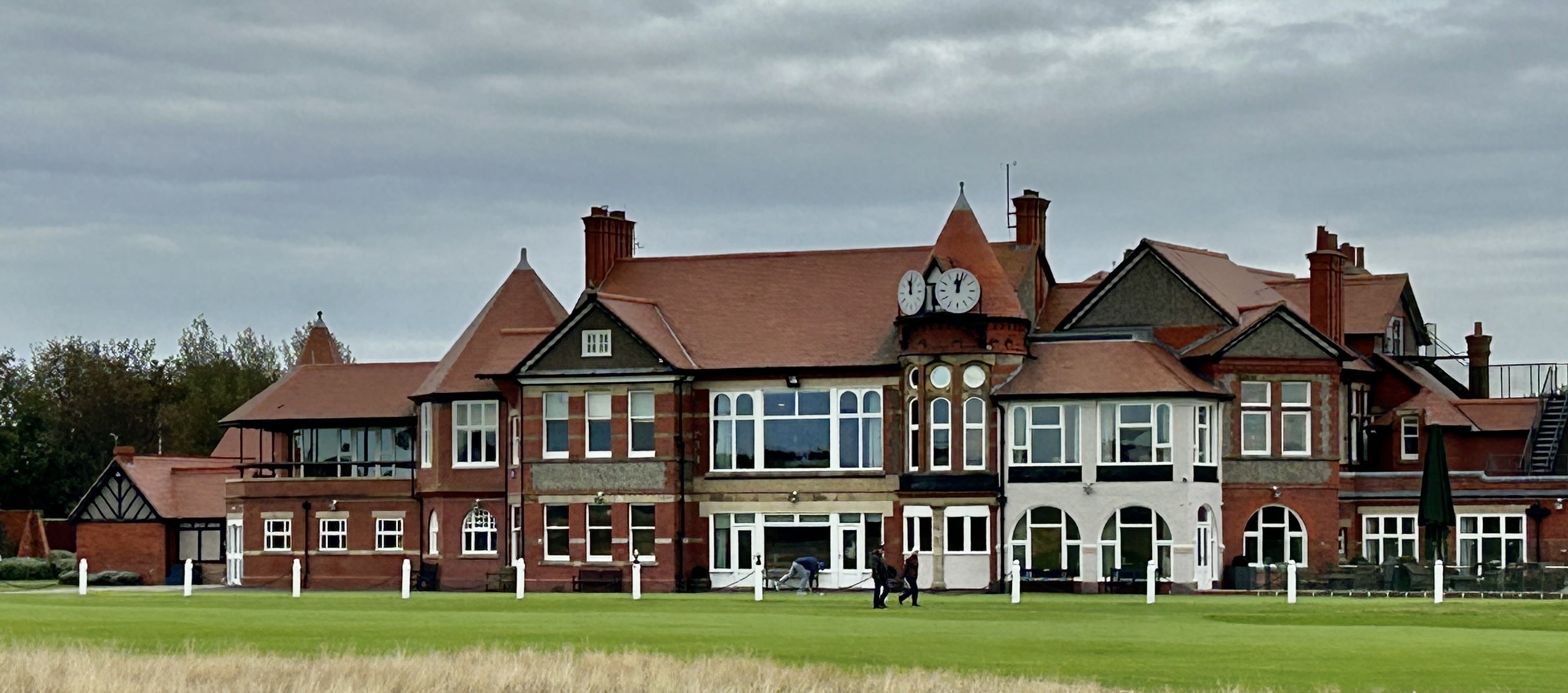
Royal Liverpool was laid out in 1869 by Robert Chambers and Old Tom Morris’ younger brother George, on a piece of land adjacent to the Irish Sea that doubled as a race track. Only two years later it received its designation as a Royal course thanks to the patronage of the Duke of Connaught. In 1885 the very first British amateur championship is held here and club member John Ball wins it and seven more times as well. He is the first amateur and Englishman to win The Open, at Prestwick, in 1890. In the last post, we learned of Bobby Jones’ feat of winning both the British amateur and The Open in the same year in 1930. John Ball was the only other person to accomplish this and he did it forty years before Jones.
In 1895 the clubhouse you see above was built, one of the first buildings dedicated solely to the pursuit of golf.
In 1892 another club amateur Harold Hilton becomes only the second amateur to win The Open. Five years later he wins it again at his home course. The only other amateur to win was of course Jones in 1930. Considering all the golf clubs in Britain there must be something in the water at Royal Liverpool to produce the only two British amateurs to ever win it. Hilton won four amateur titles plus the United States title in 1911.
In the early 20th century renowned golf architect Harry Colt was brought in to redesign the course and much of what we will play today was created by Colt. Of interest to Canadians like me, Colt also designed both the Toronto and Hamilton Golf Club courses which are ranked #6 and #7 respectively in the SCORE Golf Top 100 courses in Canada.
In 1921 the first contest between US and British amateurs took place at Royal Liverpool and the following year the Walker Cup was formalized as a biennial event that has been held for over a century since then.
In 1924 Walter Hagen becomes the first of four Americans to win The Open at Royal Liverpool, followed by Jones in 1930. Then it was another 76 years before another American, Tiger Woods, won in 2006 with a record score of 18 under. In 2014 Rory McIlroy won his only Open to date on this illustrious course.

So this course has produced not only great golfers, but great golfers have thrived here with Hagen and Woods having won 26 majors between the two of them.
On arrival our group stops for a photo in front of the ivied entrance to the clubhouse.

Inside I admire the trophies, medals and other memorabilia associated with Royal Liverpool’s great amateurs.
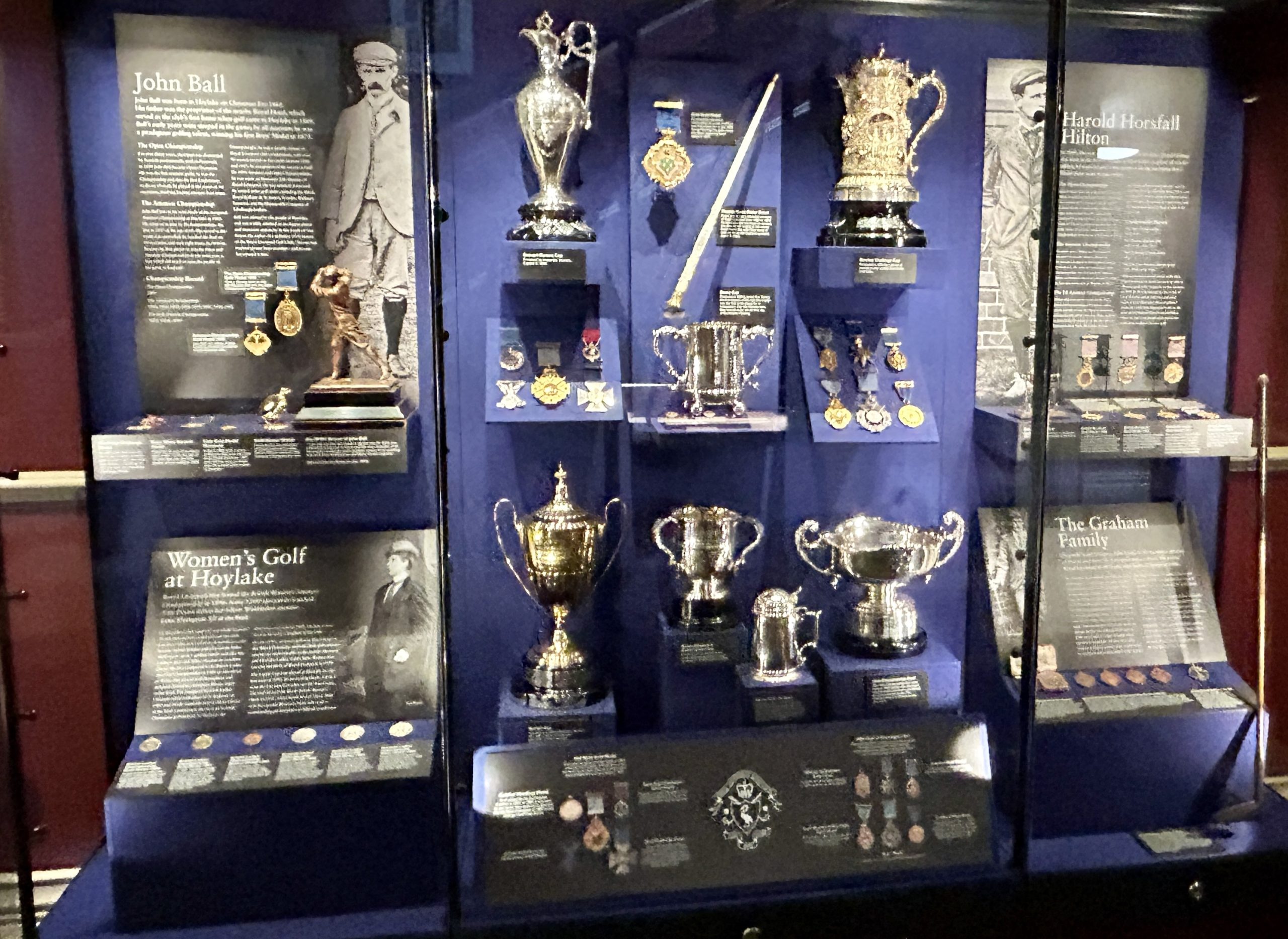
At the pro shop I buy a blue lined sweater with the Royal Liverpool logo that you can see in this photo to the left of the Hoylake Hero book. The price is really quite reasonable for a quality garment that I wore numerous times over the next week and it kept me both dry and warm even in the most inclement weather.

After checking in we do some practice putting on the only rectangular putting green I have ever seen.
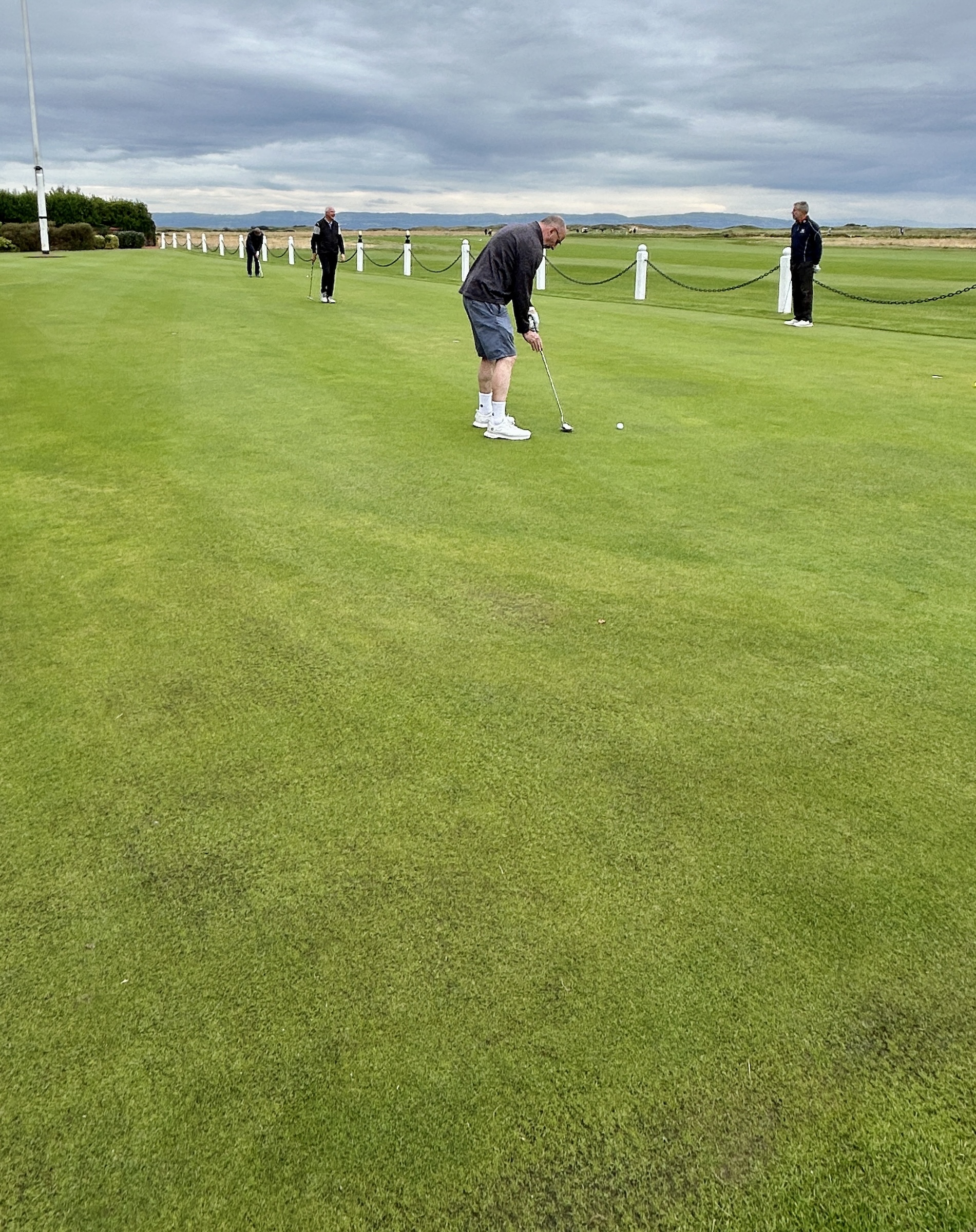
We have arranged for two caddies per foursome as most of us get trolleys aka pull carts because our bags are really too heavy to expect them to be carried. The main reason we want caddies is to give us directions, yardages, green reads and to find our errant shots and if they do all those then I can pull my own cart. My caddy is a young man by the name of Will Ward who is just entering a sports management program at Liverpool University. He is not only knowledgable, but enthusiastic and we hit it off quite well. He comes from great golf genes, his mother is a one handicap and his dad a four. I wish him all success in his future endeavours making a good living around the game of golf that he loves.

Yesterday we played the forward tees at Wallasey and given its great changes in elevation that was a smart move. Royal Liverpool is almost completely flat so we opt to play the yellow tees which are some 500 yards longer than yesterday. That’s still 1,000 yards shorter than the 7,350 yards the course played during the 2023 open.
Royal Liverpool #1 Course – 413 Yard Par Four
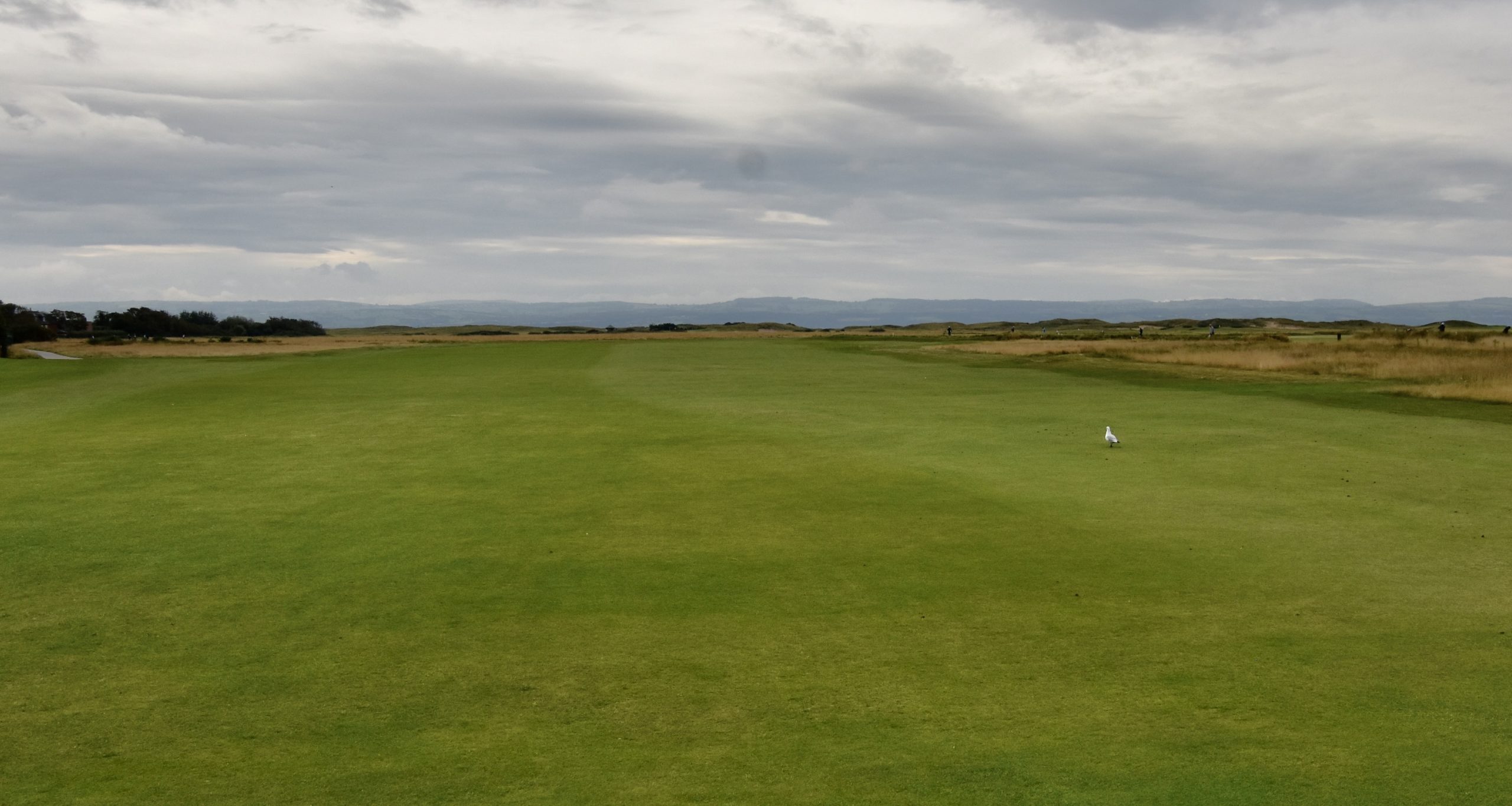
As you can see the weather is overcast and the potential for rain at any time is always a feature of Open courses. One other feature, wind, is thankfully not an issue, yet. The first hole is a tough par four severe dogleg right that requires two mighty shots to reach the green in regulation. There is ob all down the right side challenging big hitters who try to shorten the hole by trying to fly it. That won’t be any of us.
The flat fairways that are in very good condition and cut very close allow for a lot of roll, something we didn’t get much of at Wallasey. Still this will be a three shot approach for most to an oval shaped green that has next to no contour. There are no traps around the green, but the ob is not more than a few yards to the right of it. Bogie is not a bad way to start at Royal Liverpool considering what a couple of obs could do to your score.
#2 Road 356 Yard Par Four
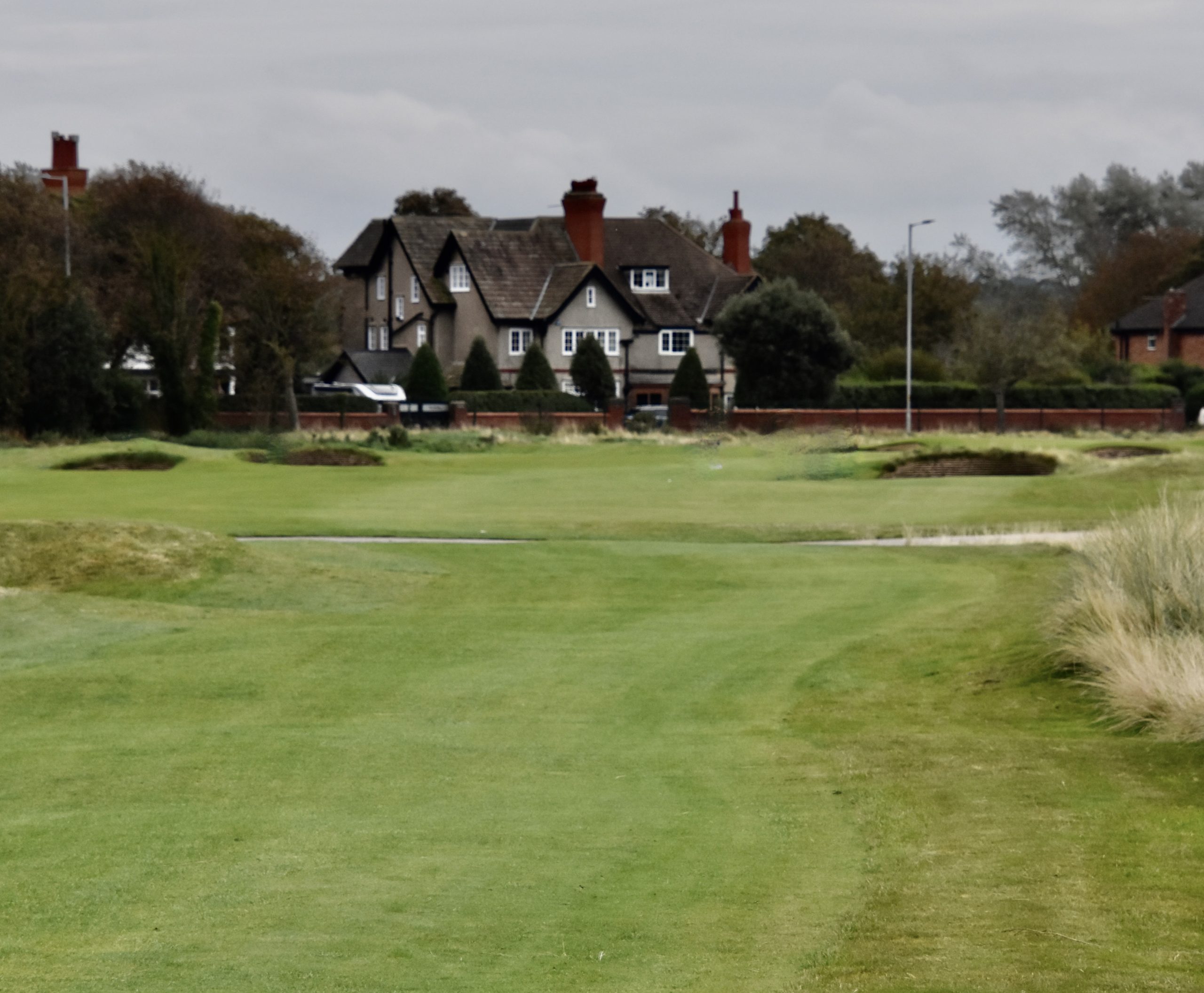
This is a much trickier drive than #1 with a narrower fairway guarded by bunkers on both sides. The photo below gives a better idea of the potential trouble here. The second shot needs to navigate between the green side bunkers to the only original green still in play at Royal Liverpool. Just think. You are putting on a green that is 155 years old. The oldest golf club in all of North America is Royal Montreal which is five years younger than this green.
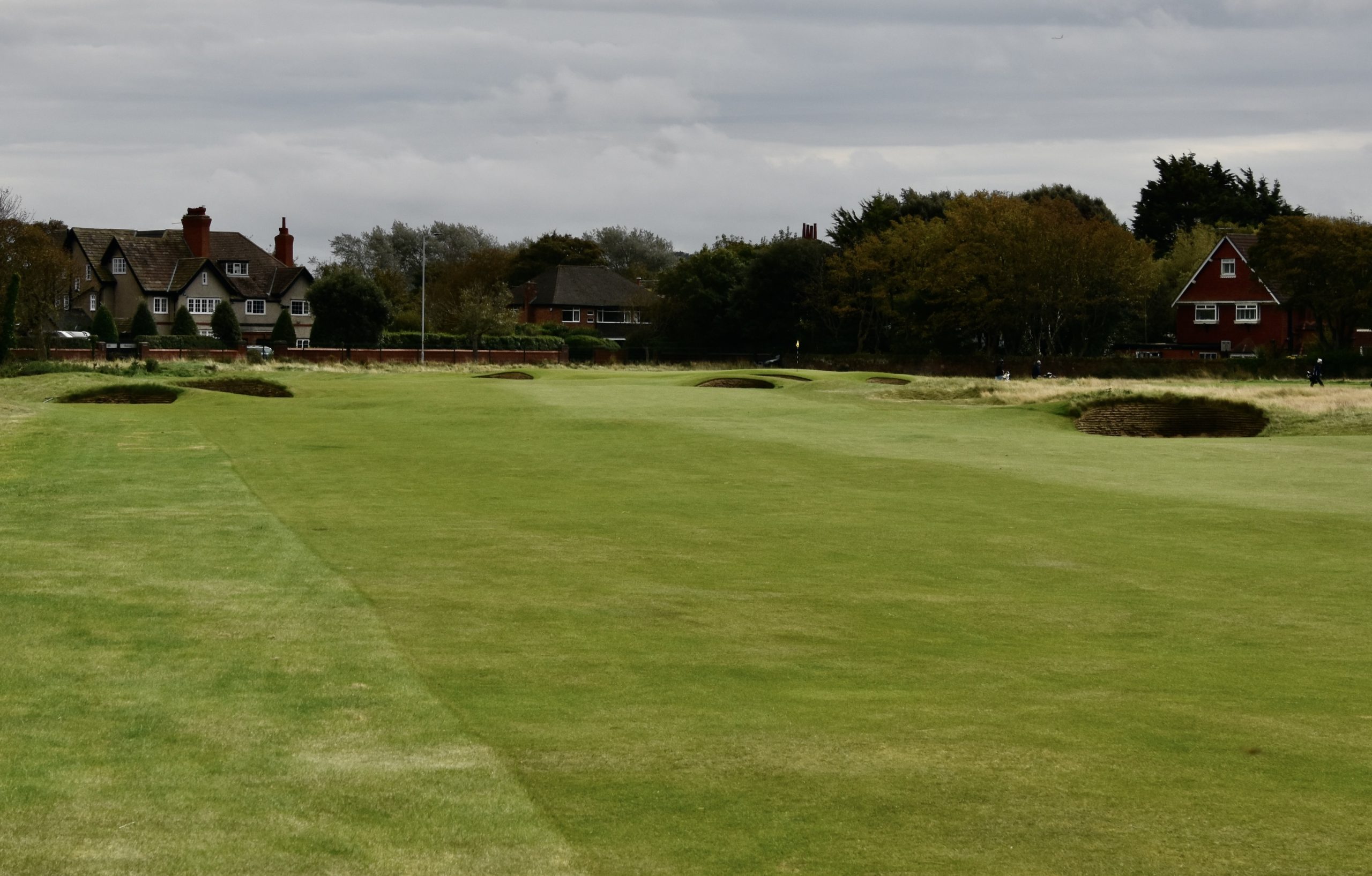
Royal Liverpool #3 Long – 485 Yard Par Five
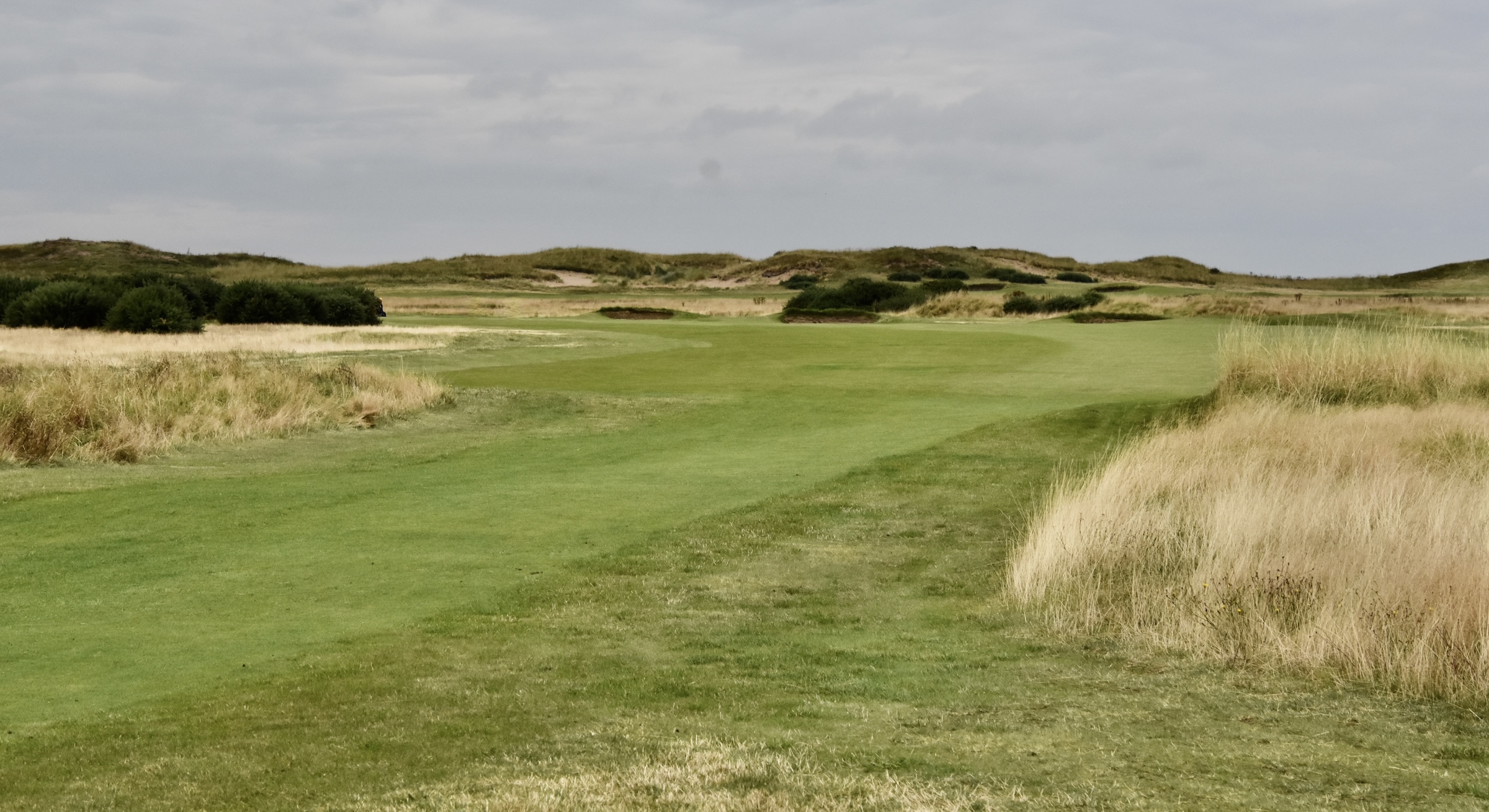
I think when they were naming the holes at Royal Liverpool they must have had to pay by the letter because these descriptors are about as terse as you can get.
The first par five at Royal Liverpool is a dogleg left that like #1, offers a risk/reward opportunity to try to shorten the hole by cutting the dogleg, but failure might result in landing in the gorse. The sensible play for guys like me is to play this as a three shot hole and avoid the fairway bunkers, fescue and gorse.
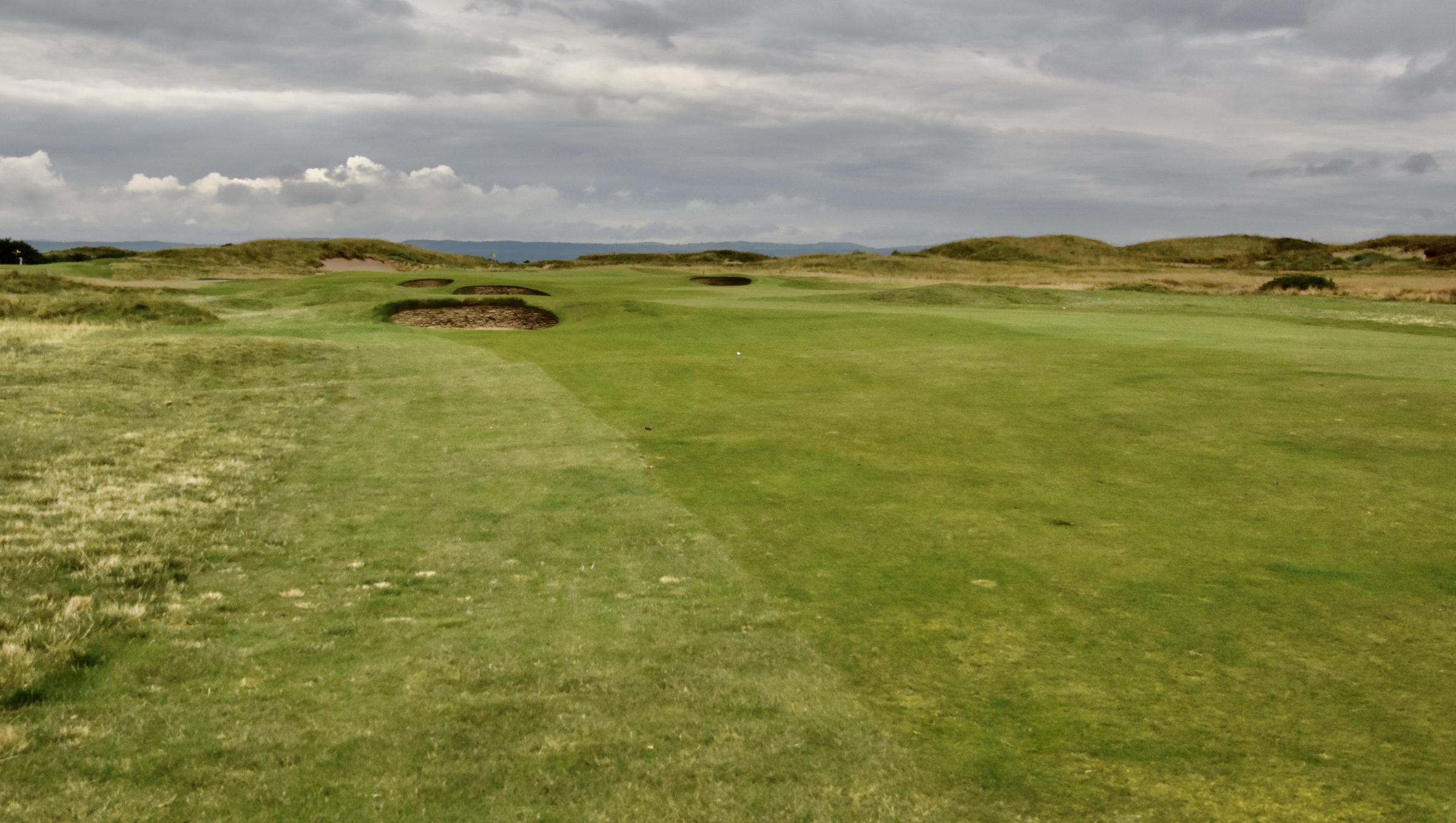
You can see my ball after two shots. It’s a nice wedge into a two tiered green. Get on the right level with the pin and this should be a fairly easy par or even birdie.
#4 New – 155 Yard Par Three
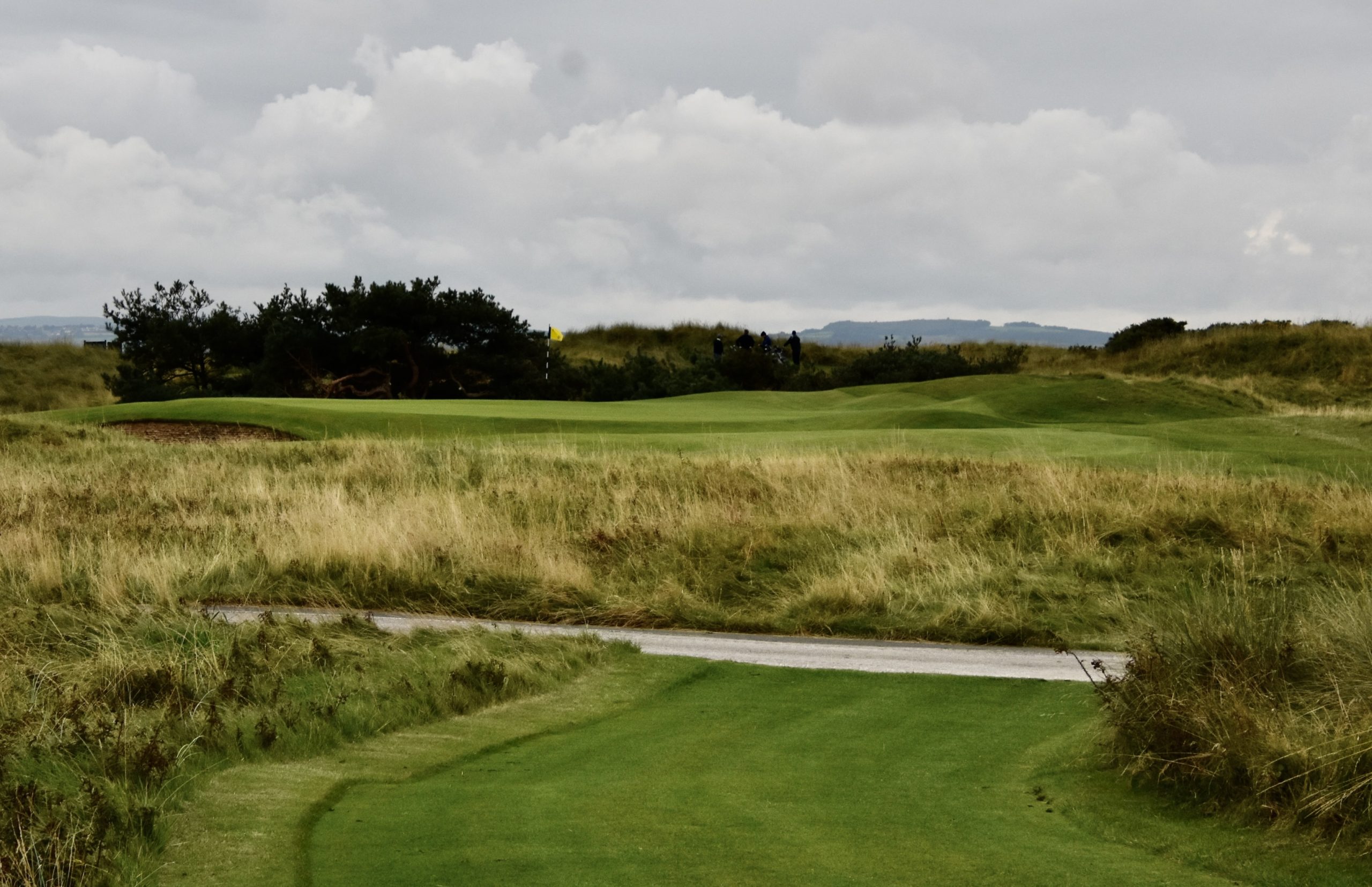
The first par three looks reasonable, but there are bunkers on the right and left that you can’t see from the tee. The green is elevated with the result that if you are short then your ball will almost certainly funnel into one of the bunkers. The green slopes up from front to back so if you do hit a decent shot the ball should advance toward the pin without much risk of going off the back.
As with almost every par three we played in England the problem was under clubbing. Convincing yourself to take at least one more club than it looks like you should need is not easy and unfortunately there’s a price to pay for not learning this lesson early on.
Royal Liverpool #5 Telegraph – 387 Yard Par Four
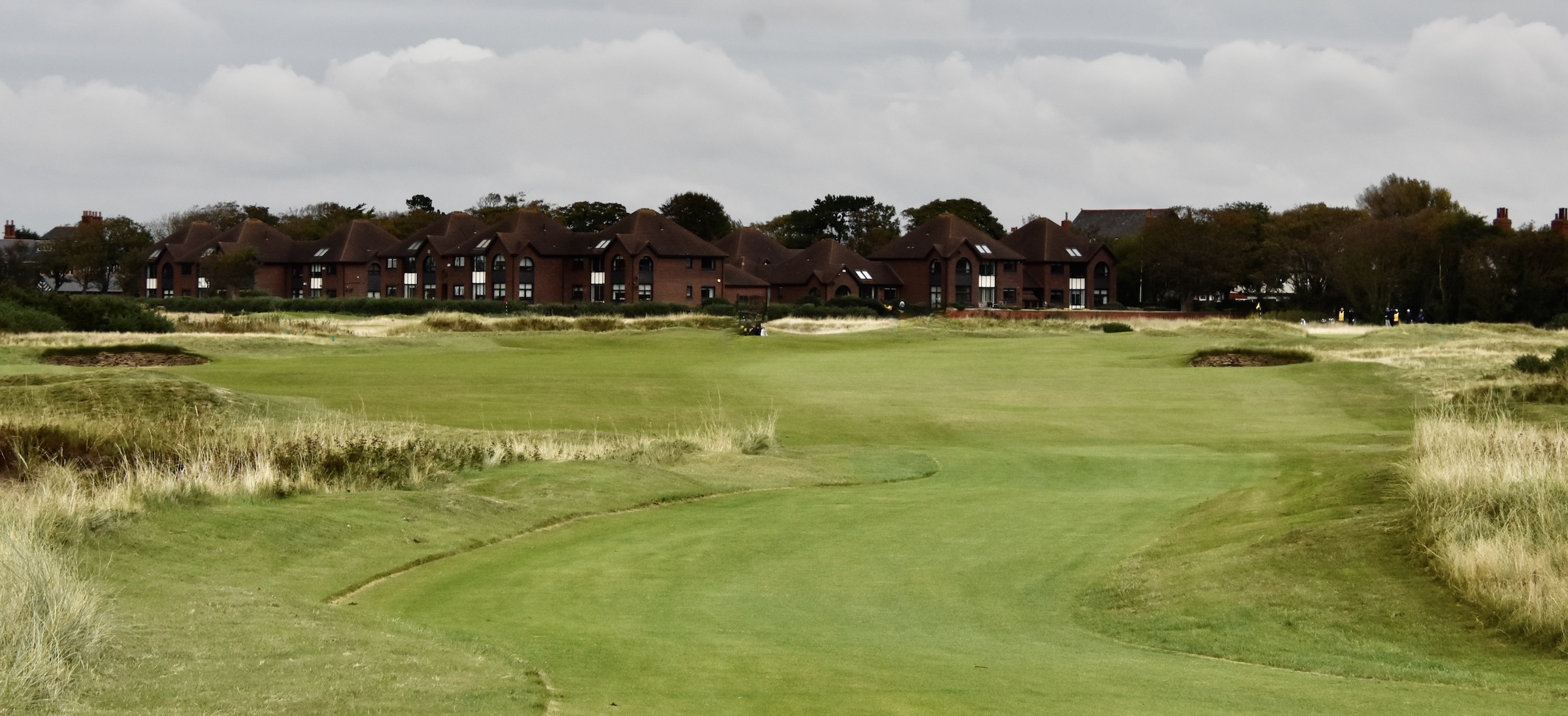
This is the #1 stroke hole at Royal Liverpool for good reason. While the fairway bunkers are not that difficult to avoid, the second shot is a bitch with the fairway virtually disappearing some 140 yards from the green. Without a decent drive you might have to make a short layup or take your chances with the rough. Another hole where playing for a bogie is not a bad strategy.
#6 Briars – 357 Yard Par Four
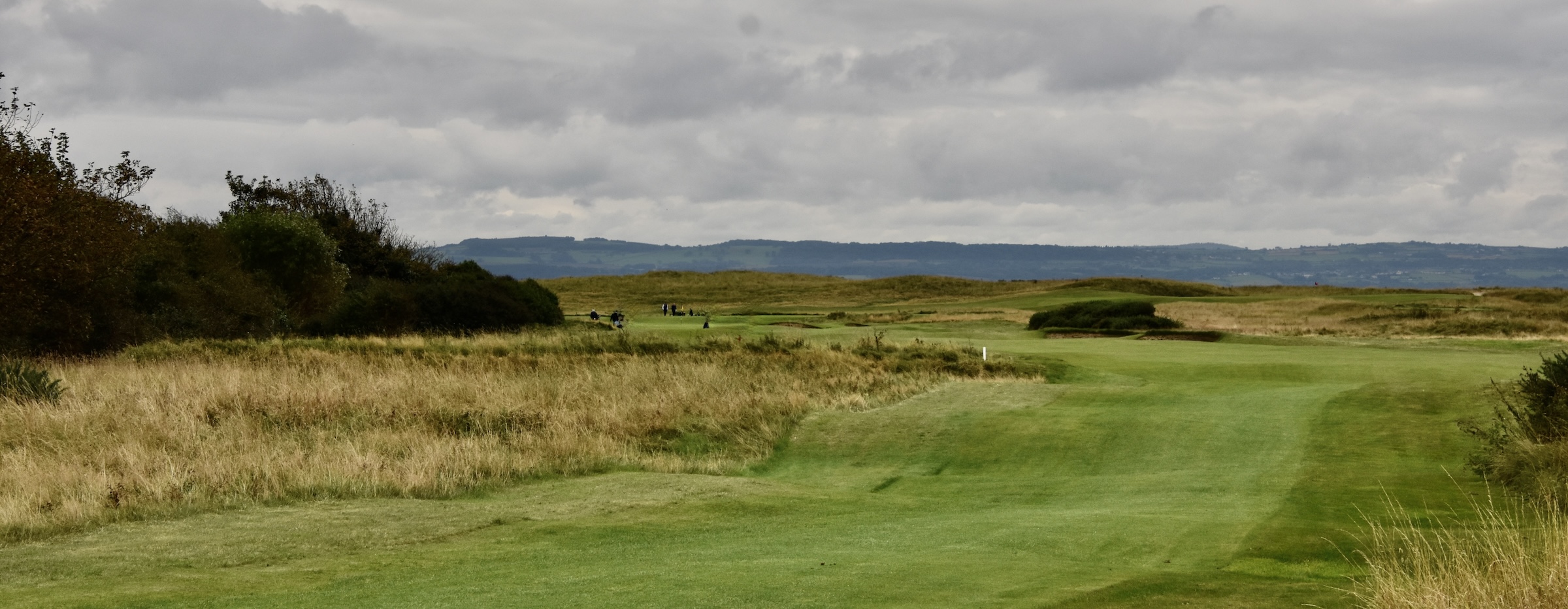
This is a tricky driving hole with ob almost right beside the fairway to the left. You can see the white stake and once again Royal Liverpool dares you to go for it. While the pros have no problem clearing it from the back tees, we are not pros and aiming well to the right is the safest play.
That should leave an approach shot something like this. There are three bunkers guarding the front of the green and the chances are pretty good that you’ll end up in one of them. As I mentioned in the post on Wallasey, the sand in these bunkers is very fine and consistent. The courses must get them from the same place. Once you get your technique down, they are not as punitive as you might think. However, there will be occasions when the ball is so close to the front wall that coming out sideways is the only feasible option.
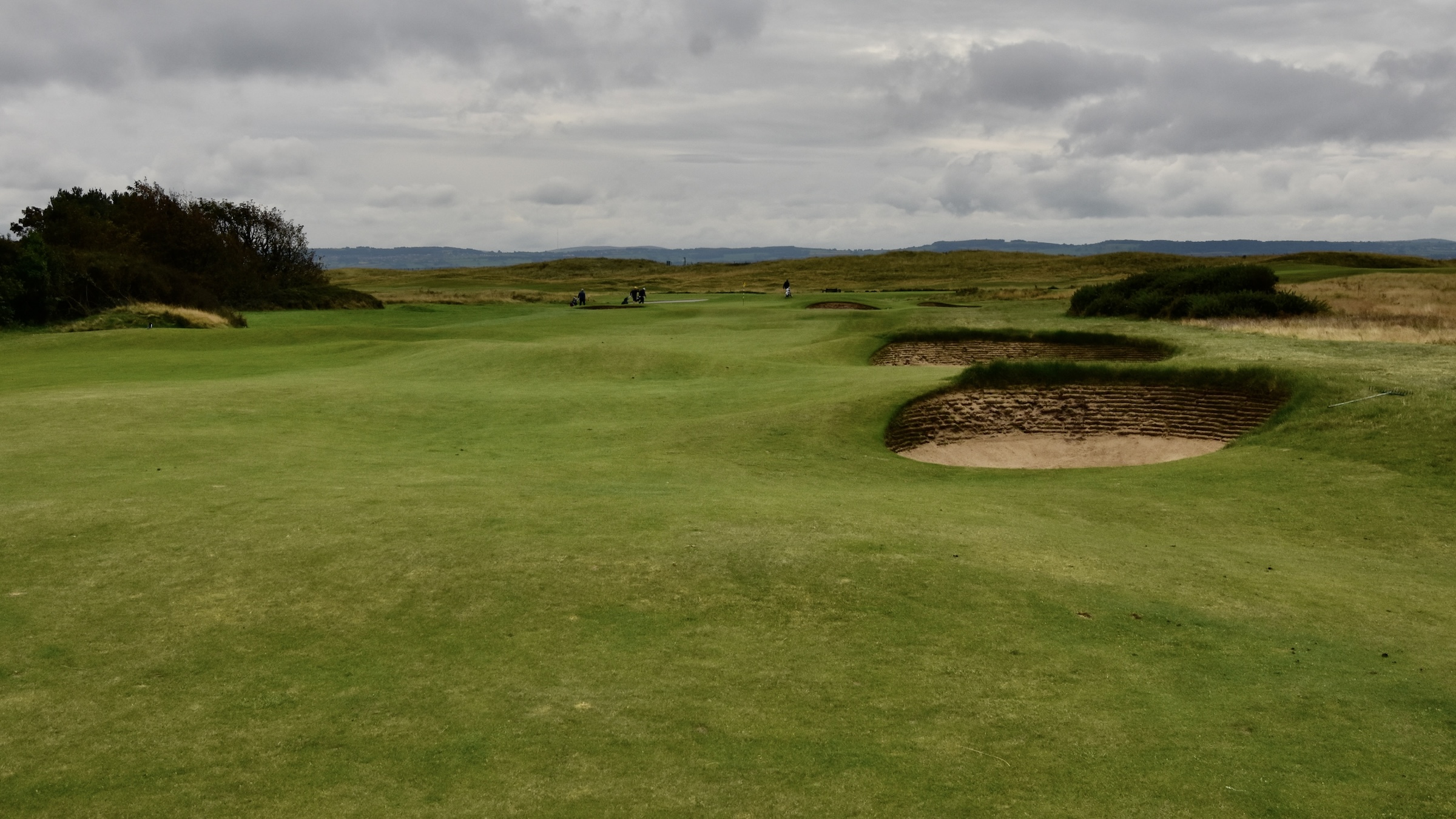
Royal Liverpool #7 Dowie – 178 Yard Par Three
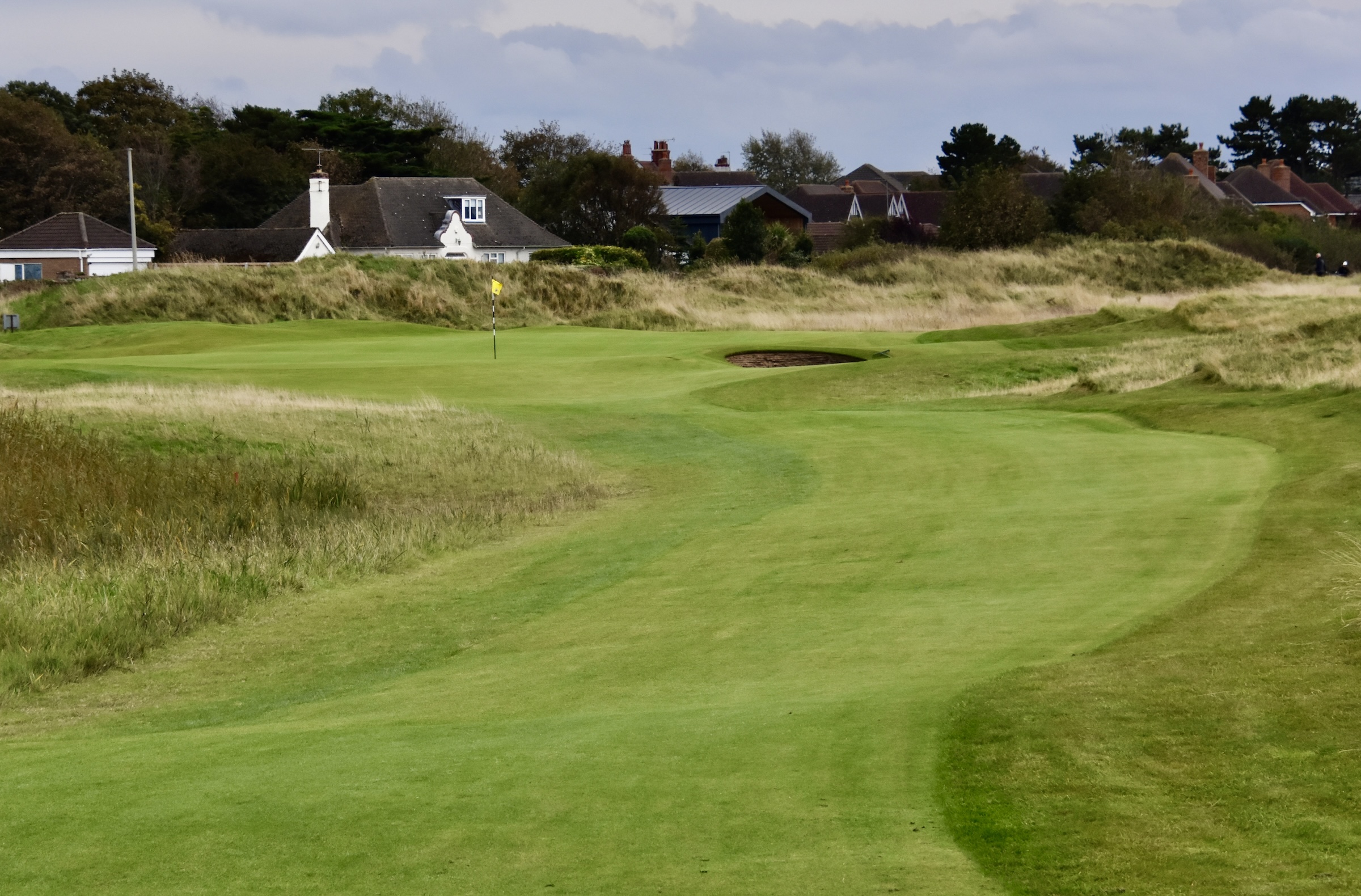
In case you’re wondering ‘dowie’ is a Scottish word for dull and dreary. Why in God’s name someone would choose to bestow that dismal name to this poor hole is beyond me. It will be dismal to go into the fescue here, but today’s pin placement is not too daunting and with the right club selection you should get out of here without feeling dismal.
#8 Far – 478 Yard Par Five
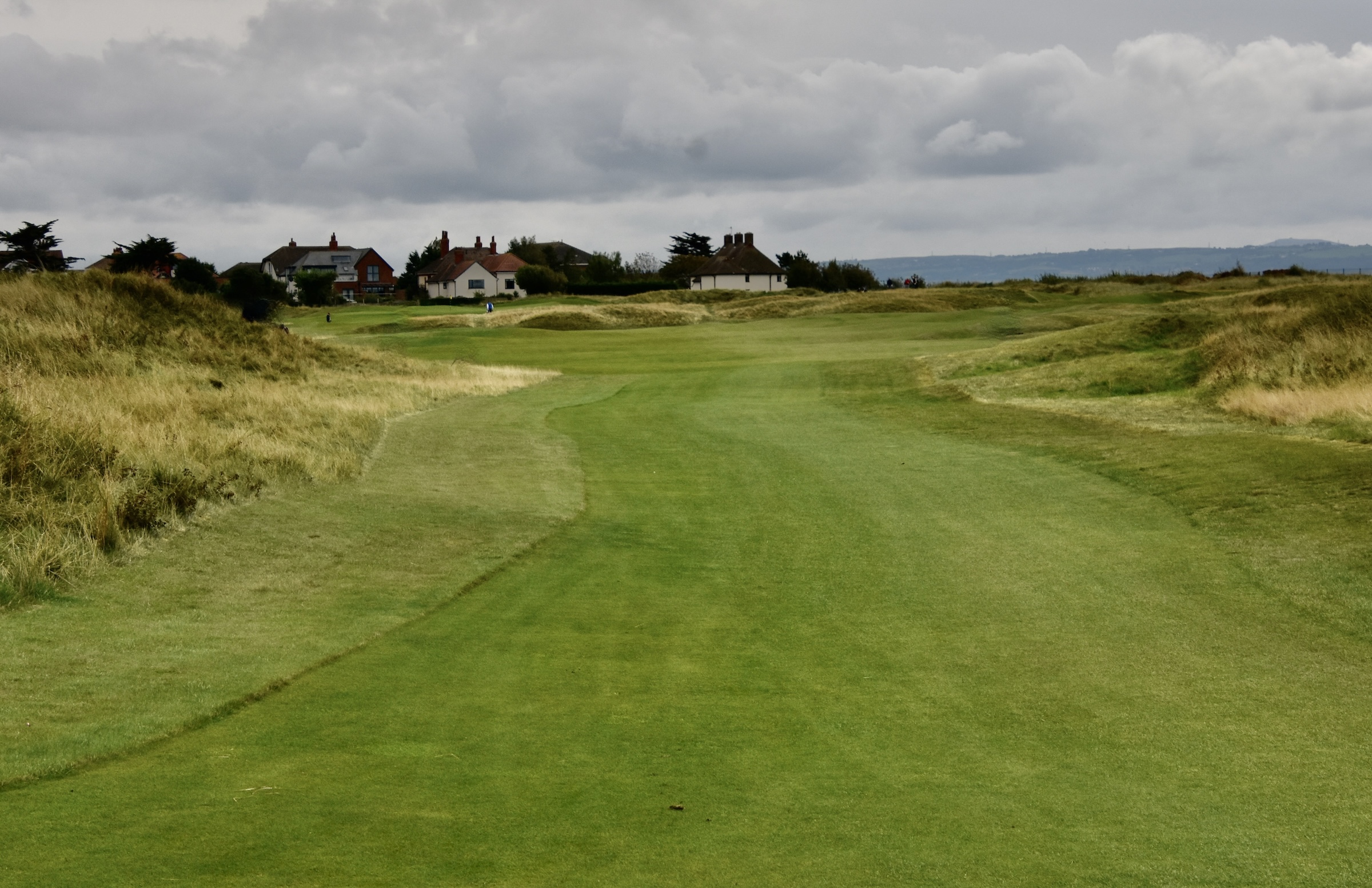
This is a three shot par five with ob all down the left side. For the drive you want get as close to the rough that almost cuts off the fairway just over 200 yards out. As you can see I didn’t do a very good job of it and now must hit a good wood to clear the obstruction and set up the approach to one of the smaller greens at Royal Liverpool.
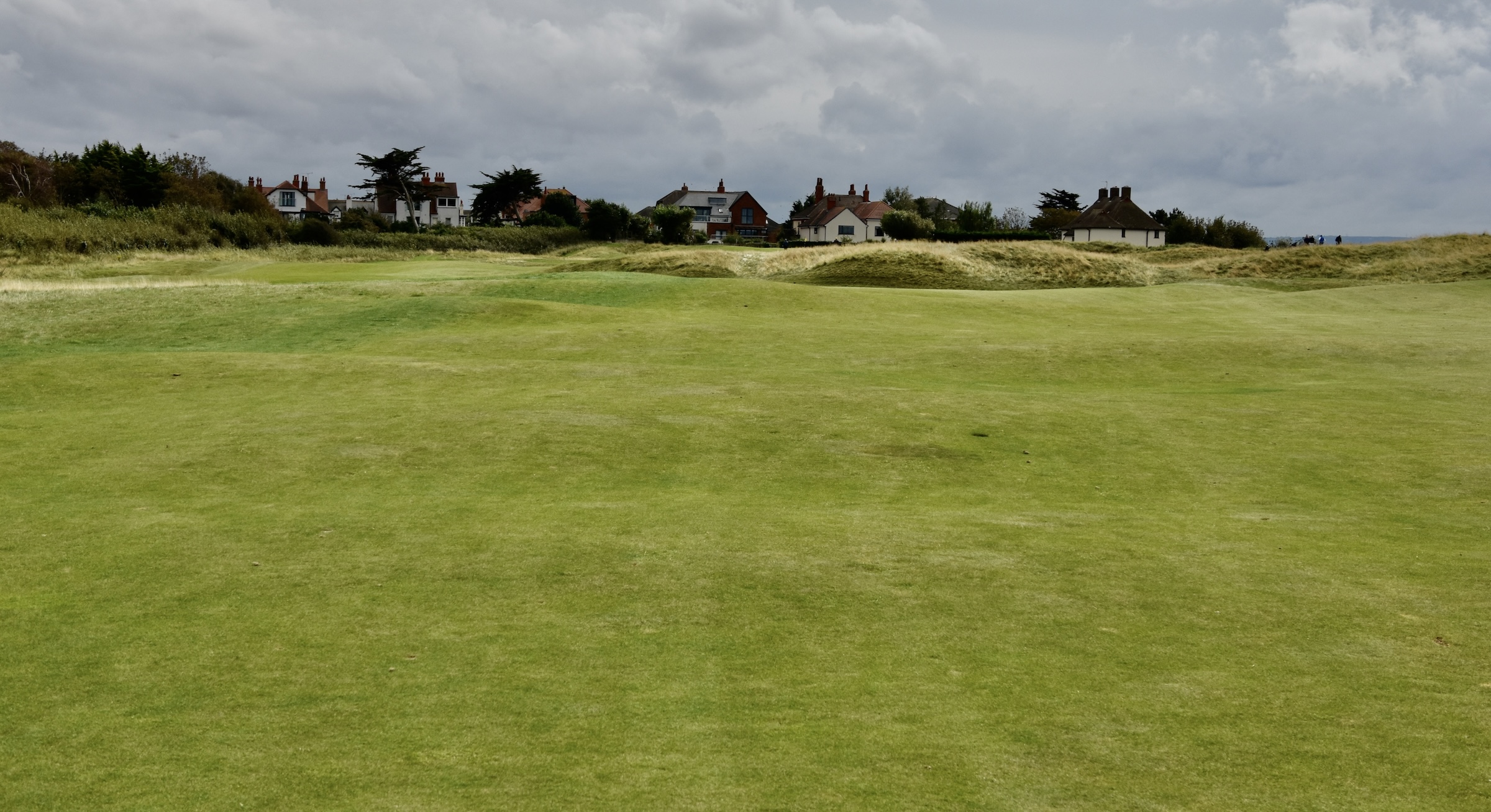
If you manage to get a six on this hole you can take solace in the fact that Bobby Jones took a double here in 1930 and called it “The most inexcusable hole I ever played”.
Royal Liverpool #9 Punch Bowl – 353 Yard Par Four
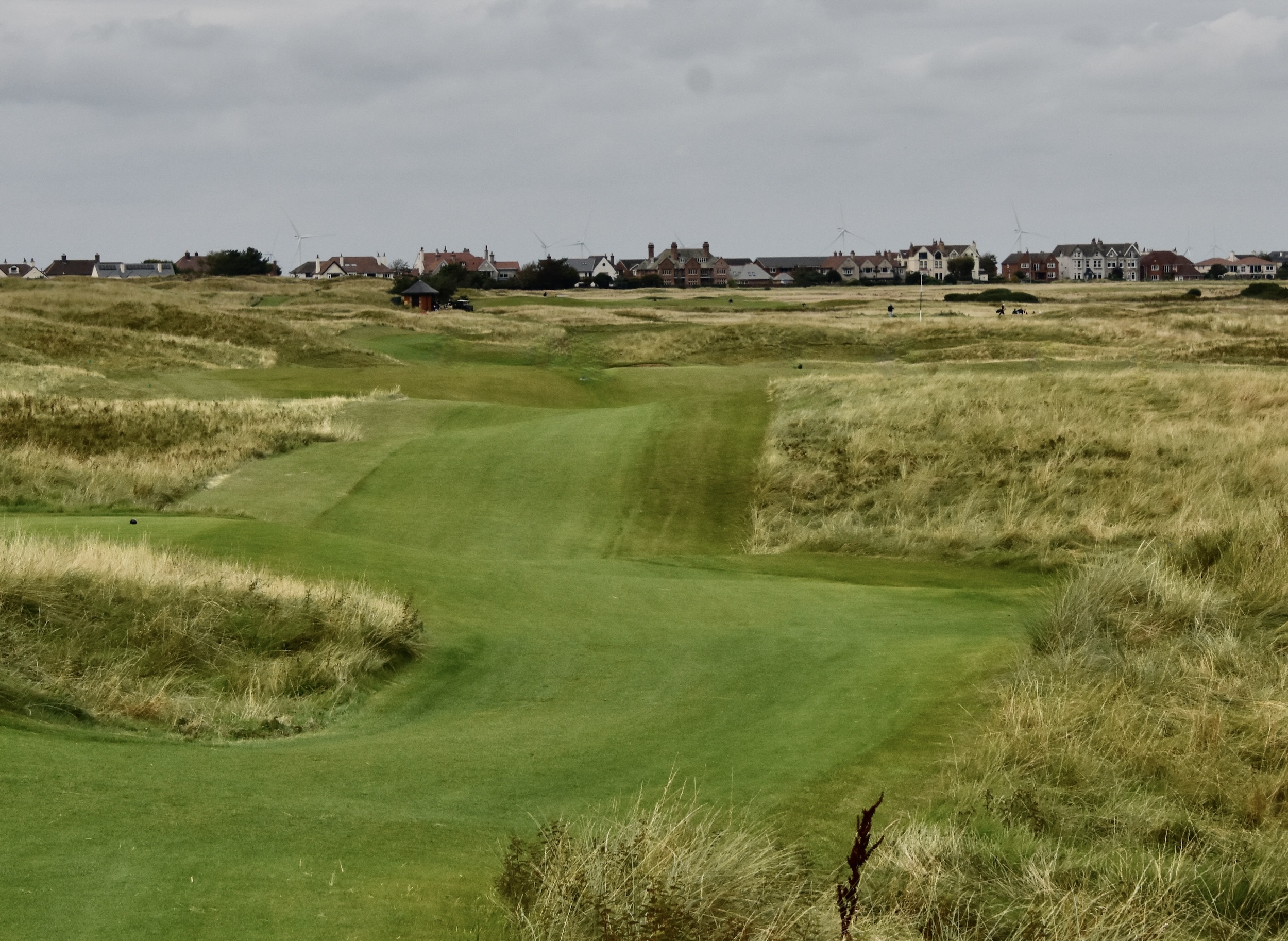
I’d be less than honest if I claimed that I was blown away by the first eight holes at Royal Liverpool. They just didn’t have the oomph that I have experienced at other Open venues like Turnberry and Royal Portrush. Playing them it didn’t surprise me that Tiger and Rory ate them up.
However, at #9 where they splurged on the hole’s name, things started to get interesting. At this point you are quite close to the River Dee estuary and Will pointed out the hills of Wales on the other side. Just looking at this hole from the tee box you have to wonder how in hell’s name you are going to hit this fairway.
The good news is the the fairway does widen out more than it looks and there is a decent chance you will land on it. The bad news is that you might have a blind second shot. This is where I ended up after two shots which was actually not too bad and afforded a straight bump and run onto the green. This is the third stroke hole at Royal Liverpool and there are a lot of ways to go wrong on it so five is quite acceptable.
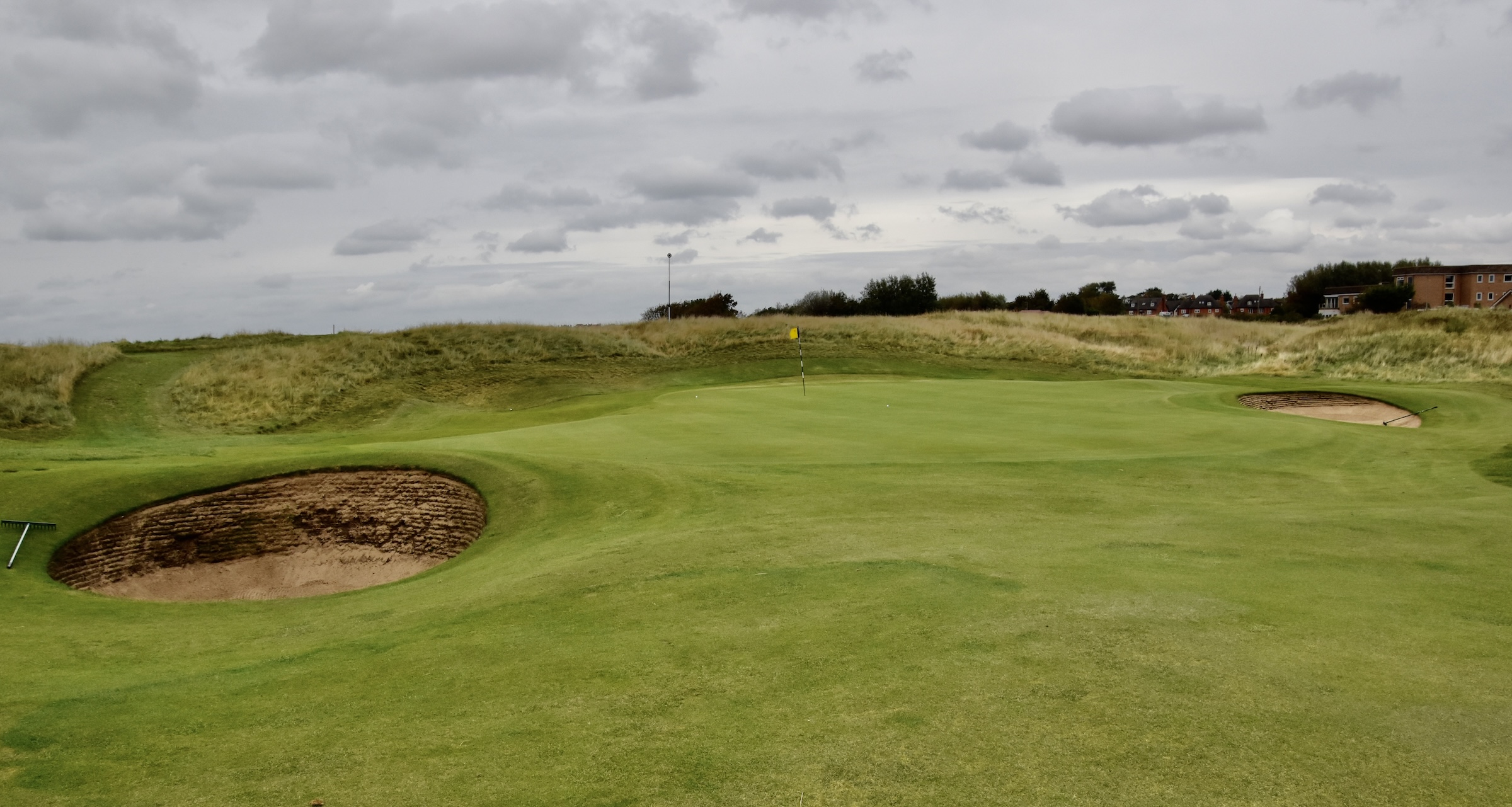
#10 Dee – 358 Yard Par Four

As with almost all links courses, Royal Liverpool does not return to the clubhouse after nine, but rather you are miles away from it.
#10 is a dogleg left that has a fairly decent carry off the tee to get to the meat of the fairway. From there its a still a long way to the green. Kind of a return to the sameness of the first eight holes.
There is a small halfway house between #10 and #11 where this gull was waiting for any errant flakes from the sausage rolls some ordered. He got nothing from me as I stuck to beer.
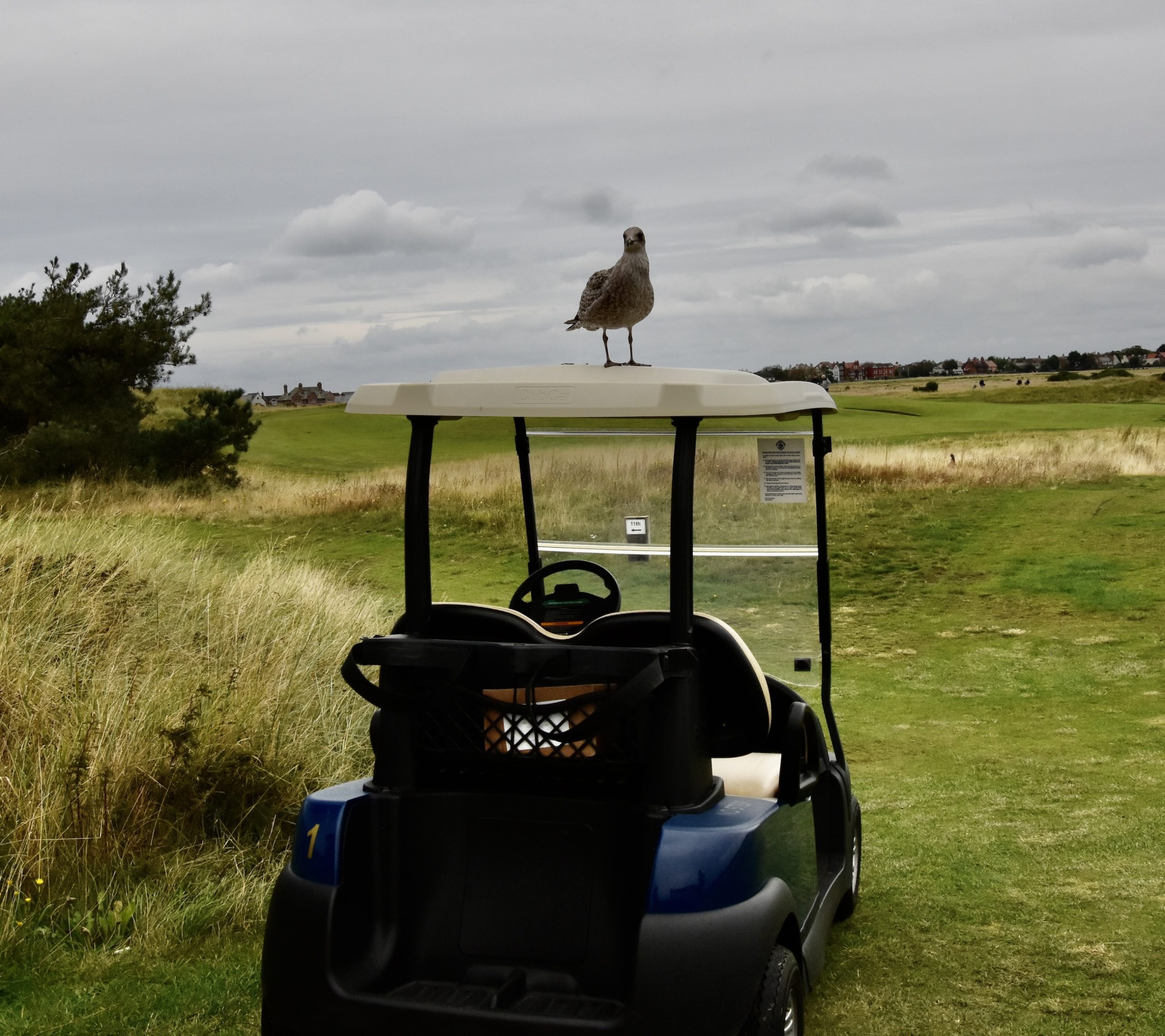
Royal Liverpool #11 Alps – 165 Yard Par Three
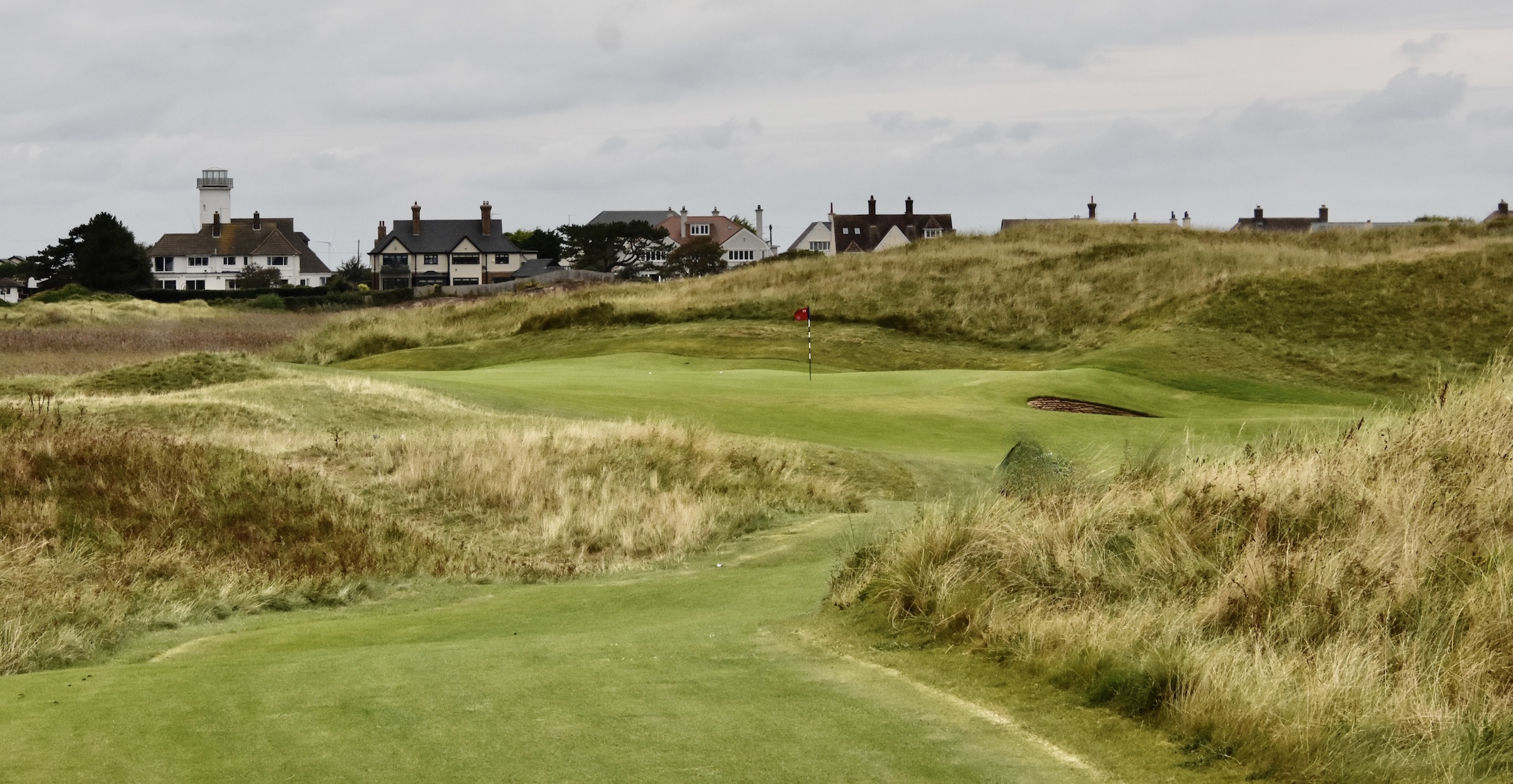
Although this picture doesn’t show it, this hole runs right alongside a broad beach and you are finally getting some very good looking golf holes. Given the relative lack of elevation change at Royal Liverpool I suppose Alps is not too much of an exaggeration in naming this hole. The wind is now blowing and club selection is again the priority on this hole. If you look closely, you can see two balls on the green. I wish I could say one of them was mine.
#12 Hilbre – 383 Yard Par Four
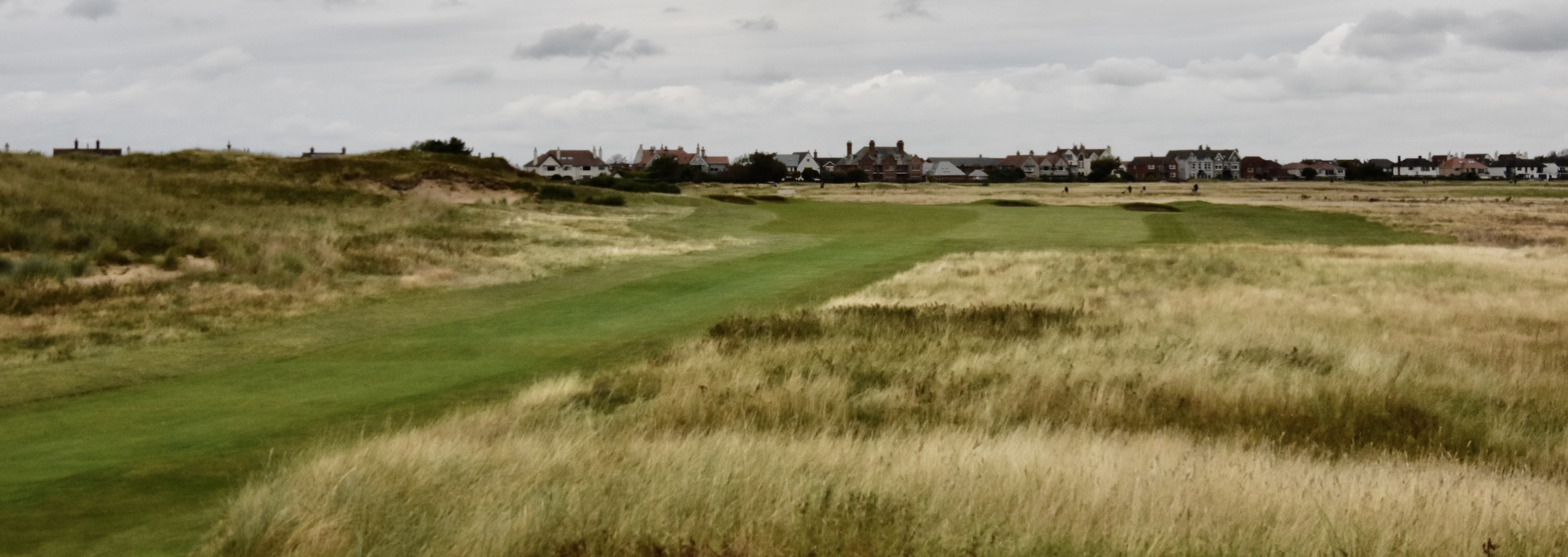
This is generally considered to be the signature hole at Royal Liverpool although I think the new 15th might surpass it in the coming years. The name derives from Hilbre Island that you can see from this hole. It is named after St. Hildeburgh who supposedly resided there as a female hermit in the 7th century. This hole is yet another dogleg left with bunkers to the right and left and probably the most difficult approach shot of any of the par fours. The green is tucked between small fescue covered dunes and requires flying the traps that guard the left side if you are not all the way over on the right side of the fairway. Another hole where bogie is not a bad score.
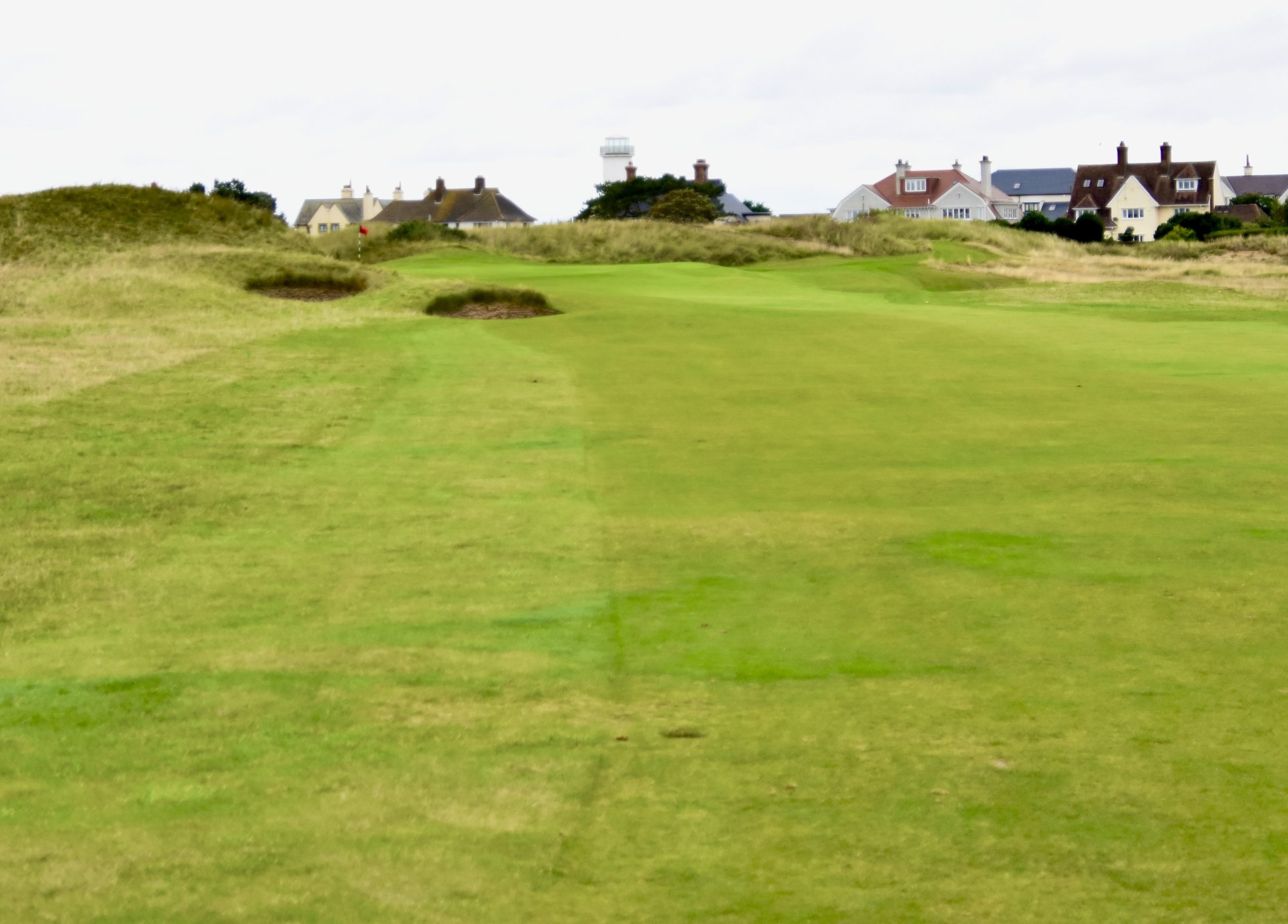
Royal Liverpool #13 Field – 493 Yard Par Five
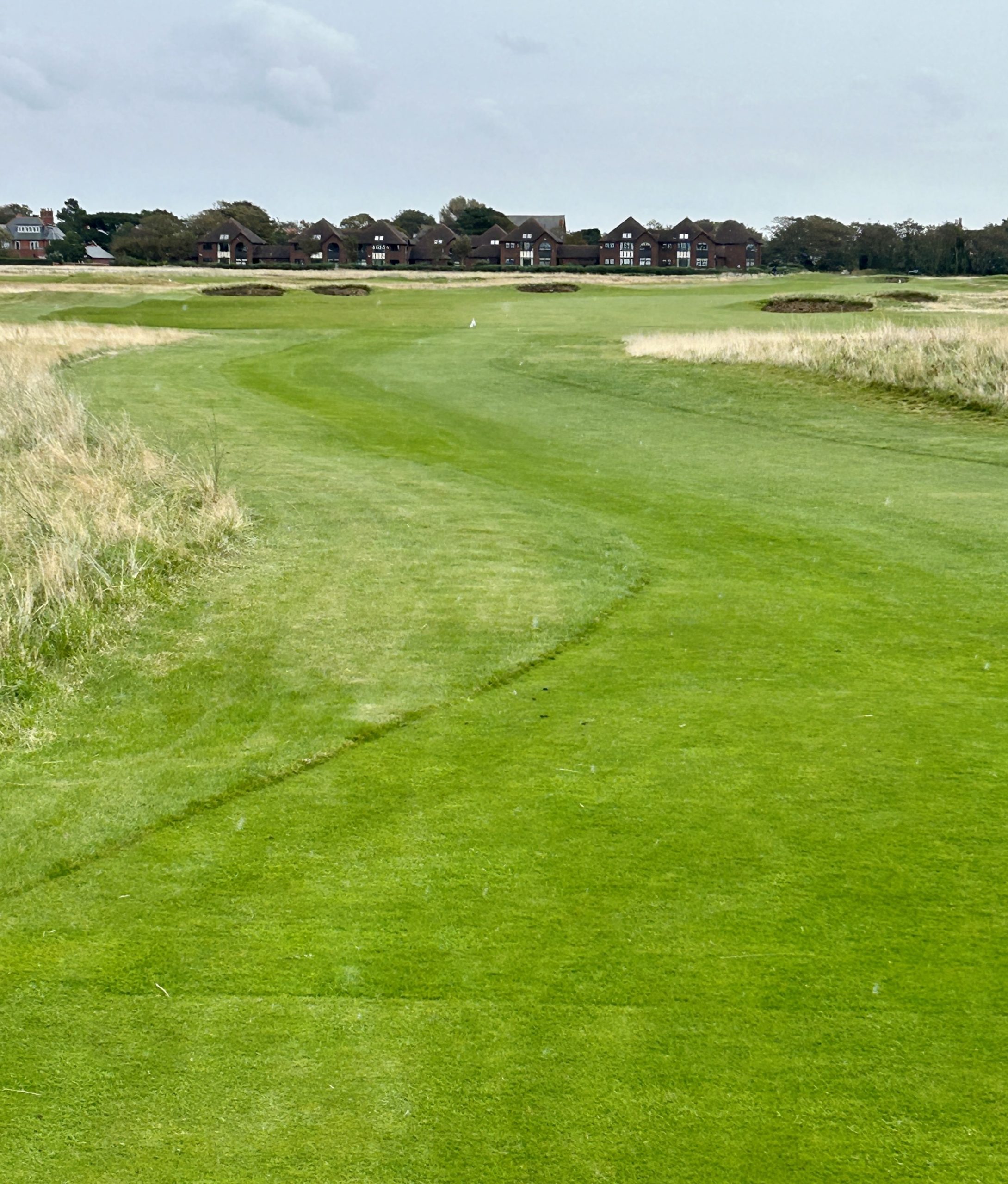
The six finishing holes at Royal Liverpool are where The Open is won or lost, starting with this hole that tips out at 614 yards from the championship tees, and yet it is the #18 stroke hole, a rarity for a par five. In other words for the pros birdie is a must here. For normal people it is a three shot hole that begins with a drive to a fairway where bunkers are very much in play. Avoiding these today is not that difficult, but I can’t imagine playing this course in a strong wind.
This is the third shot to a very flat featureless green. This along with a number of other holes at Royal Liverpool, offers opportunities to play the bump and run approach as very few holes have bunkers at the front that demand a pitch shot.
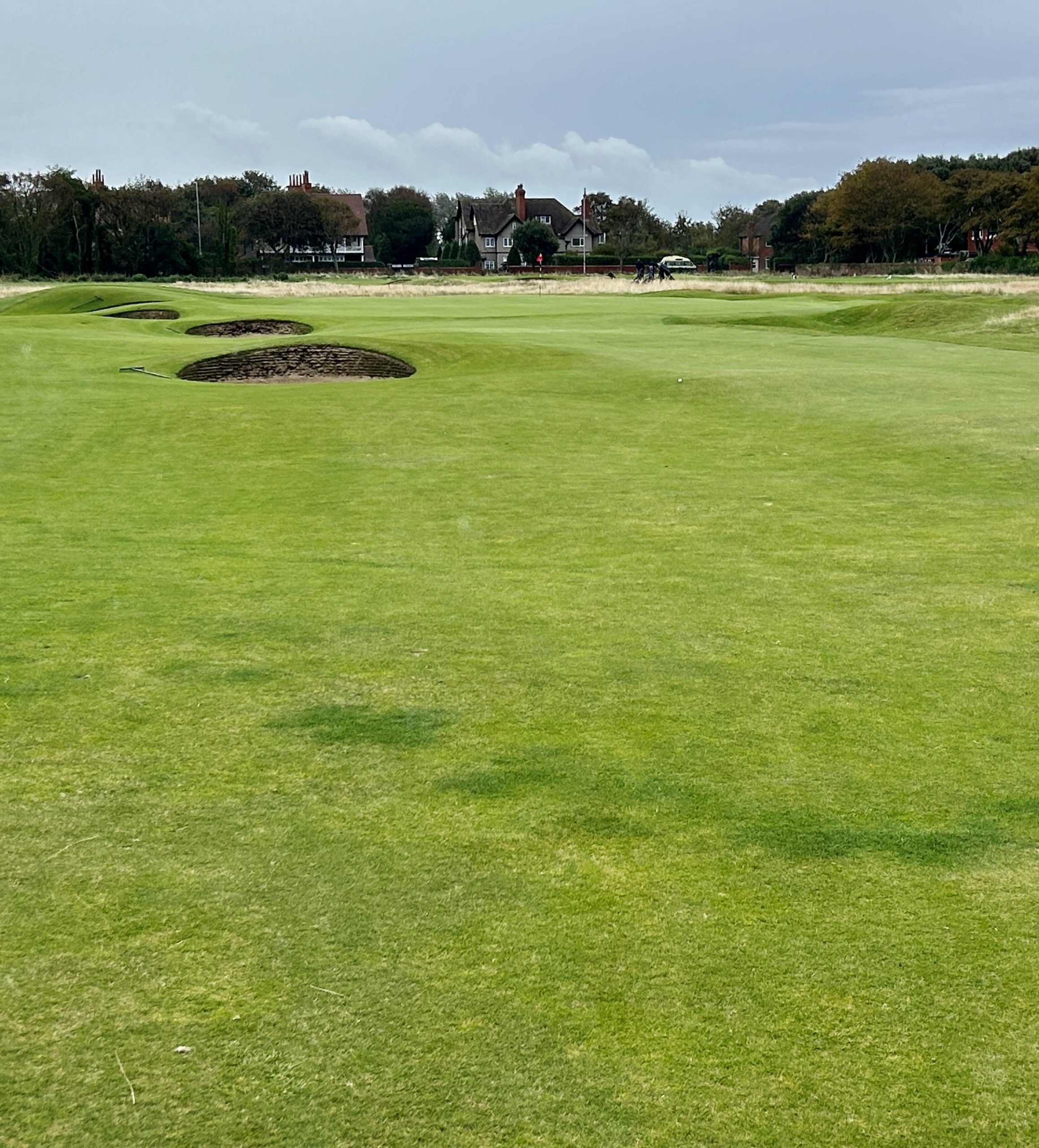
#14 Lake – 417 Yard Par Four
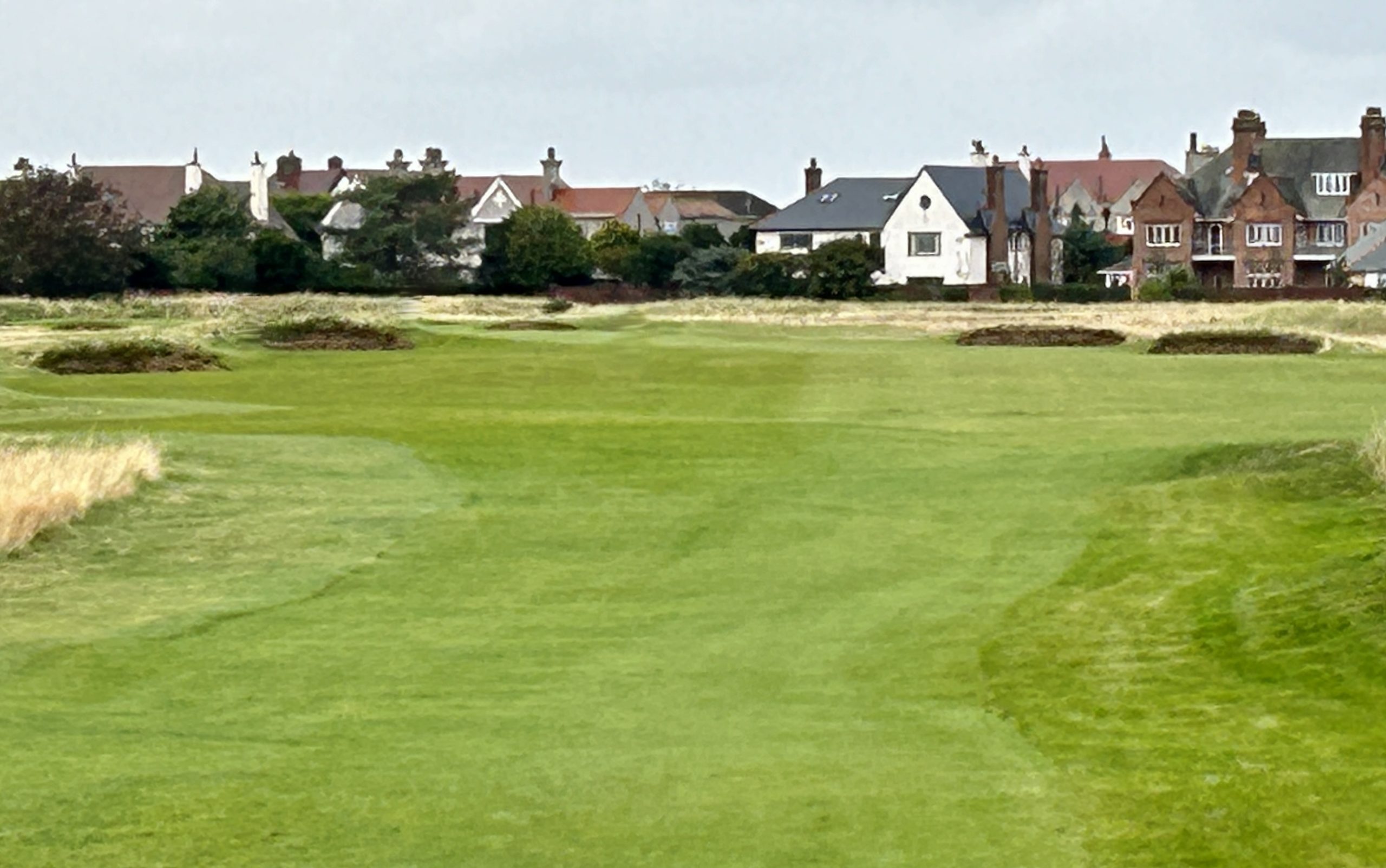
If there’s a lake on this hole, it is well hidden. This is the approach shot if you’ve hit a great drive and avoided the bunkers off the tee. Unlike some other Open courses, you will not find any pot bunkers at Royal Liverpool that are actually embedded in the middle of the fairway. All the trouble is consistently to the sides which frankly gives it a bit of a monotonous look. The course really rewards someone who can hit a straight drive which sounds axiomatic, but that’s not the case at places like Royal Troon or Carnoustie where the bunkers are liable to show up anywhere, gobbling up what at first appears to be a great drive down the middle.
Royal Liverpool #15 Little Eye – 107 Yard Par Three

This is a hole that was only created in 2020 and for me was the most interesting hole at Royal Liverpool. While its not long you are hitting up to a crowned green that slopes off in all directions. It requires pinpoint precision to hold the green even in benign conditions like today as I found out.
This what this hole looks like from above. Incredible!

I hit a solid wedge that came up one yard short, thought about going toward the pin and then gravity sucked it back into the huge bunker that guards the front. Although I was able to get the ball out of the bunker it was impossible to hit it hard enough to stay on the green and each time it rolled back in. After three tries I surrendered.
I was in good company as Tommy Fleetwood and Matthew Fitzpatrick saw their Open hopes go up in flames on this hole when they had a double and a triple respectively. For the 2023 Open this hole was the 17th which made it much more important not to get into trouble here because there were not enough holes left to stage a recovery.
Despite being massacred here, I think this is a brilliant hole and as predicted on #12 I think it will become the signature hole at Royal Liverpool. BTW Little Eye is a tiny island in the Dee estuary that you can see from the green.
#16 Dun – 506 Yard Par Five
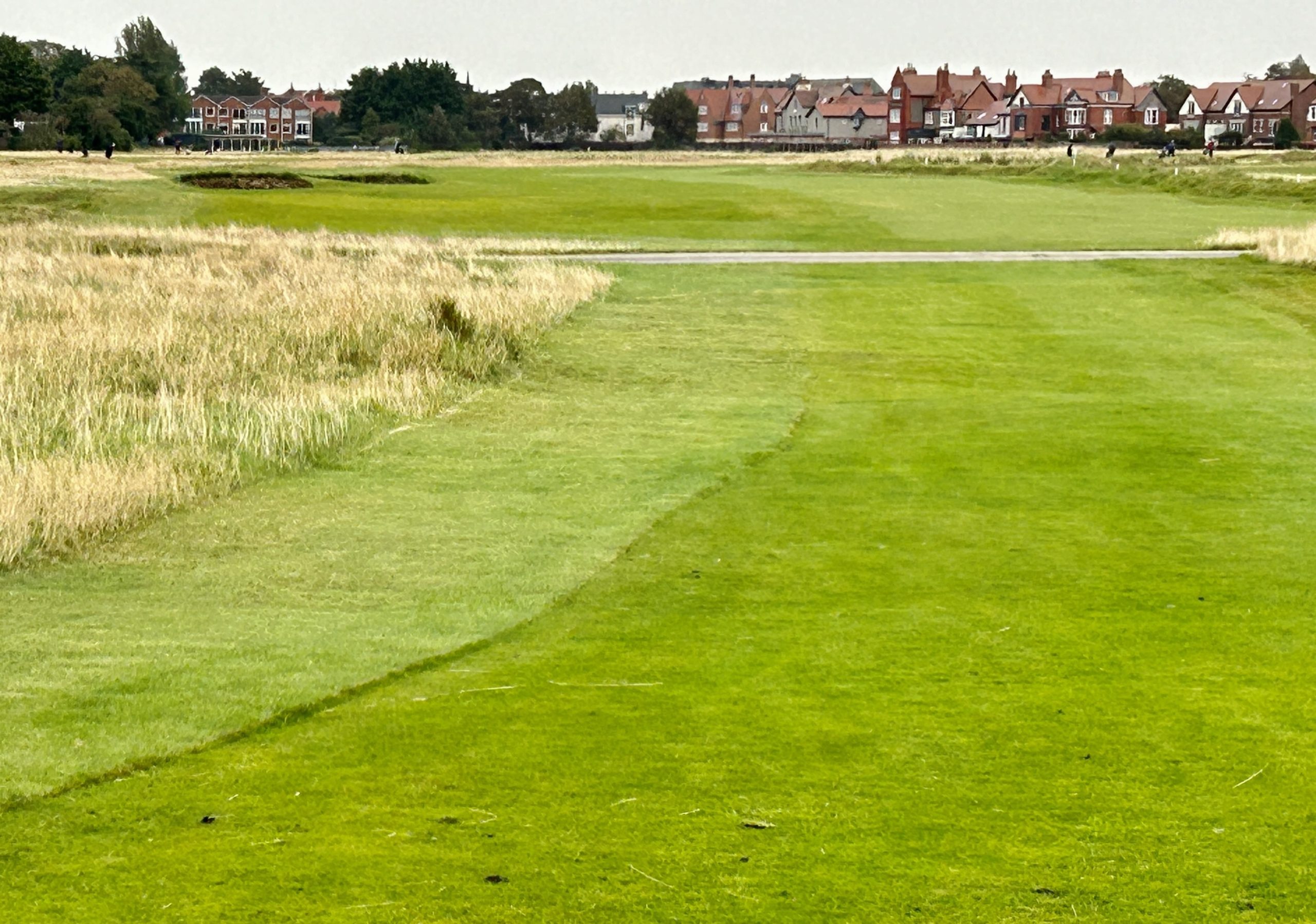
This hole is a longer version of #1 with ob all down the right side of a dogleg right to probably the most difficult green on which to avoid the bunkers (I’m not counting 15 which is in a league of its own). There are five and depending where the pin is you might have to challenge them. This played as the 18th hole during the 2023 and at 611 yards from the tips presented a real risk/reward to challenging the ob to get a shot at reaching the green in two. Unfortunately there wasn’t much drama as Brian Harman was ahead by six strokes and simply played for par.
Royal Liverpool #17 Royal – 370 Yard Par Four
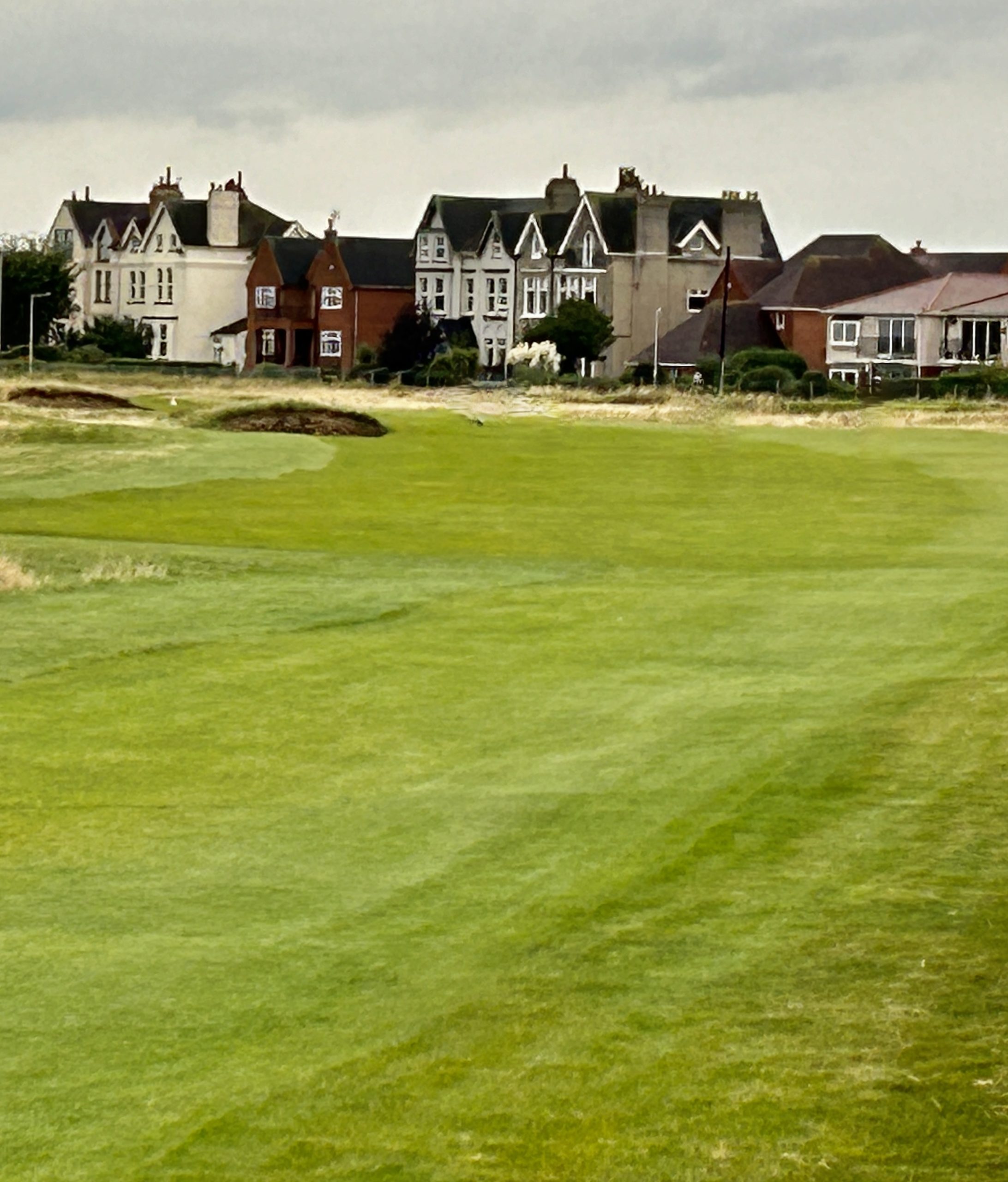
This hole was #1 at the 2023 Open and the penultimate hole for us. Since the 12th hole it has been sprinkling so I had to switch to my iPhone for the photos which is why the resolution is not as good. I found the houses on this and 18 to be a bit of a distraction in terms of the aesthetics of the two finishing holes. This is not an easy par four, but not particularly notable or distinguishable from many that have come before it.
Royal Liverpool #18 Stand – 374 Yard Par Four
The rain really opened up here and I wasn’t able to get a decent photo of #18 which is too bad, but if you go the Royal Liverpool website and click on this link it will take you to a Time Line. Scroll down to 1930 and you’ll find a Movietone video showing Bobby Jones on the 18th and later accepting the Claret Jug. You will be amazed at how much golf has changed since then with Jones wearing plus fours with a shirt, tie and sweater. His driver looks more like a seven wood. Jones retired at age 28 after being the only golfer to ever win the Grand Slam in one year and his accomplishment at Royal Liverpool was a major part of that feat – no pun intended.
Next our group will head up to the Blackpool area to take on Royal Lytham St. Annes.

